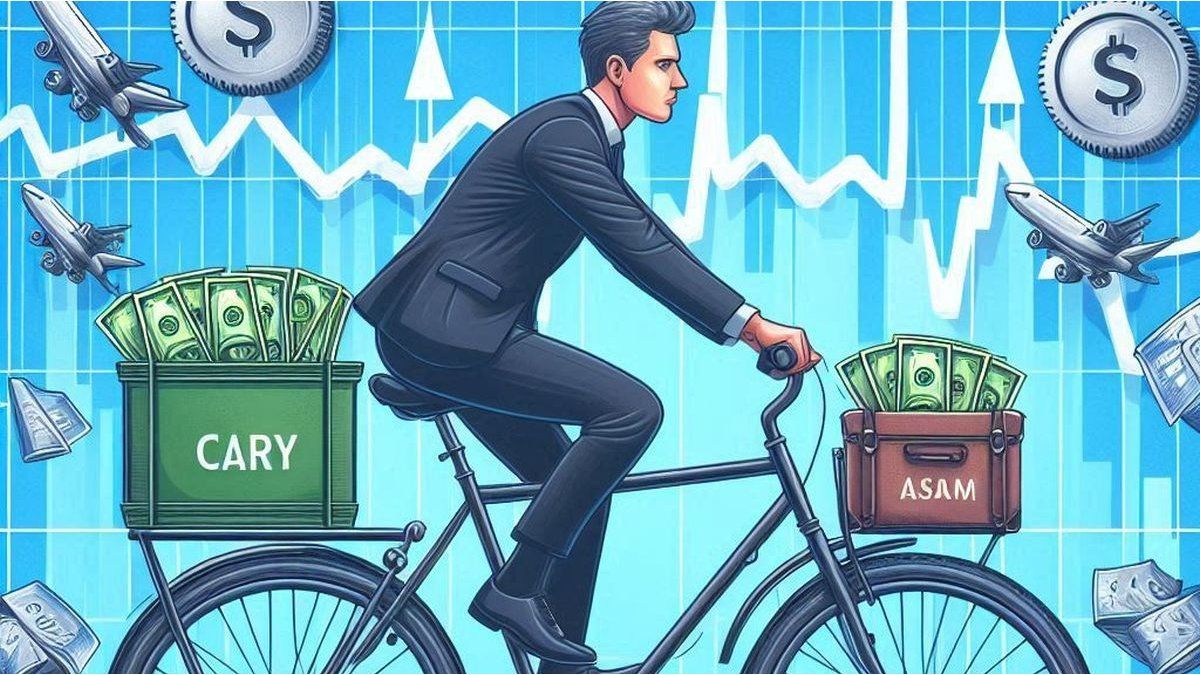In the current financial panorama of Argentina, the sustainability of the “carry trade”, or “financial bicycle” basically depends on two key elements: reducing the monthly crawling peg from 2% to 1% and obtaining fresh dollars. These actions not only reflect necessary technical adjustments, but also highlight the complexities inherent to this strategy in a context of high macroeconomic and social fragility.
What is the “carry trade” and what is its dynamics in emerging economies?
The carry trade is an investment strategy that consists of taking debt in a currency with a low interest rate to invest in another currency with a higher interest rate. For example, it could happen that a large Argentine company with access to international credit in 2025 took out loans in dollars at 7% per year, entered the dollars and, exchanging them for pesos, placed the proceeds in the simplest investment (fixed term) in pesos at 31.5 Annual % at 30 days (TEA: 34.47%). The potential gain would come from the difference between both rates, adjusted for the variation in the exchange rate (TEA:12.68%). Although this practice is common in international markets, in emerging economies such as Argentina it entails significant risks, such as abrupt fluctuations in the exchange rate and crises of confidence. Although the 2024 profits are unrepeatable, it is clear that even a spread of 21.79% is not common anywhere in the world.
In the Argentine case, carry trade operations have historically generated positive returns for international investors, who enter at the beginning of favorable cycles and withdraw before the risks materialize. However, these returns are often obtained as compensation for the high country risk, today RP is 569 basis points, considerably low for Argentina. In recent financial crises such as that of 2018, it was evident how a massive outflow of capital can trigger severe exchange and financial crises.
Handling and regulations
Even in developed markets such as the United States and Europe, planned and unplanned exchange rate fluctuations have led to market manipulation investigations. Cases such as Citibank and JP Morgan, forced to pay multimillion-dollar fines in 2014 for manipulation in the foreign exchange market, or the imprisonment of Barclays trader Andy Verity in 2023 for interest rate manipulation, demonstrate that risks and conflicts of interest are intrinsic to these strategies.
In Argentina, the carry trade and its actors are not exempt from controversies. The sustainability of the mechanism often depends on government decisions related to the exchange rate and interest rates. Overdependence on this scheme can ensure sky-high profits or lead to abrupt crises, as happened with the LEBACs in 2018 (Sturzenegger-Caputo).
The price of the carry trade
To attract speculative capital, a government must maintain generous interest rate spreads calculated in dollars, which in turn undermines the fiscal balance in the medium and long term, because it also increases fiscal and quasi-fiscal costs in a deferred manner. According to the Ministry of Finance, Argentina’s public debt increased in just 10 months, US$91.88 billion as of October 31, 2024reflecting the cost of financing this type of strategies, including the “nationalization of the BCRA’s commitments with local banks” (issuance of financial instruments to regulate the amount of pesos in circulation). In most cases, these policies have ended abruptly, generating economic instability and social consequences.
Reduction of crawling peg and need for dollars
The first measure to sustain the carry trade is to reduce the monthly crawling peg from 2% to 1%. This adjustment would presumably offer investors greater predictability in their returns. However, this action must be complemented by obtaining fresh dollars to guarantee an increase in international reserves and ensure the liquidity of the financial system, avoiding suspicions of an eventual balance of payments crisis.
Currently, private external debt has become an explicit alternative to attract dollars. The government would be managing a super loan from the IMF, and has just obtained a loan of US$ 1,000 million between 5 banks. Remember that during the third quarter of 2024, private sector loans amounted to around US$4.8 billion. This strategy presents risks if the indebtedness with multilateral credit organizations and private banks in foreign currency is not oriented towards productive investments that generate income in dollars. The use of these funds for speculative purposes increases the country’s vulnerability to exogenous shocks.
Lessons
Argentine economic history offers clear lessons about the dangers of excessive dependence on financial capital. Since 1976, on several occasions, similar policies led to “desubindustrialization” and an increase in external and internal debt. Financial openness consolidated an external dependence that exacerbated vulnerability to global crises.
Examples such as the overvaluation of the peso with debt that flooded the country with imported products, harming the national industry between 1977 and 1981, show how errors in the design of economic policies can have devastating consequences. These lessons reinforce the importance of designing sustainable and development-oriented strategies.
Ratifying, to sustain the carry trade in Argentina in 2025 it is essential to reduce the crawling peg from 2% to 1% monthly, and guarantee the entry of fresh dollars “ceteris paribus” (Marshall); that is, ignoring other risk factors, and imagining that all other macroeconomic variables will remain unchanged. However, these measures must be implemented with institutionality, laws of Congress, with a long-term vision that reduces dependence on speculative capital and promotes more stable sources of financing. The latter would not be happening. Recent history shows that the continuity of policies based on carry trade usually leads to abrupt crisesevidencing the need for economic planning that prioritizes stability and sustainable development.
This strategy usually becomes unsustainable and fails as a result of the combination of the following design errors:
- Exchange rate appreciation and “desubindustrialization”: The overvaluation of the peso favors imports and tourism abroad, harming the local industry and is already affecting the national summer business. Prices in Argentina are currently among the most expensive in the world, and they are not only dollars in air tickets and hotels abroad, but also meals, clothing and electronic products.
- Increase in indebtedness with the IMF and placement of debt in voluntary markets: New financing from the IMF and private banks increases the debt and aggravates the weakness of the domestic economy in the face of any exogenous shock.
- Increase in internal debt: The public debt has already grown until October 31, 2024, around US$ 92,000 million, according to the Secretary of Finance of the Nation.
- The trilemma, or “the impossible trinity” always ends badly: This concept of “international economic policy” indicates that it is inadmissible for a country to simultaneously maintain a fixed exchange rate, the free movement of capital and an independent monetary policy (Fleming Mundell). These authors stated that no more than two of those three objectives could be achieved. Bob Mundell is the same author that Milei invokes when it comes to the “principle of effective classification of markets” and was winner of the Bank of Sweden Prize in Economic Sciences in memory of Alfred Nobel in 1999. Mundell proposed in 1962 this concept trilemma in his work on monetary and commercial theory.
- Black swan: It is an improbable phenomenon or event that happens unexpectedly with important consequences, such as “September 11”, “a tsunami”, “a drought”, “a pandemic”, “a war”. Black swans are an accessory part of our routine world, and the worst thing is that we cannot identify this phenomenon until it has happened. This is because human beings tend to investigate matters already known, leaving aside everything that is unknown, and, mostly, abstracting from the sovereign will of God. This makes any voluntaristic determination to simplify and narrate the future based on what is known extremely vulnerable.
We warn that the continuity of this strategy not only keeps the Argentine economy in a cycle of perpetual vulnerability, but also increases the risk of an abrupt and disorderly outcome. When the pillars that support the carry trade – confidence in exchange rate stability and access to external financing – falter, the fall can be as rapid as it is devastating. Persisting in this logic, without attacking the structural distortions that perpetuate dependence on speculative capital, is like walking on the edge of a cliff blindfolded; a strategy as bold as it is dangerous.
Director of Esperanza Foundation. https://fundacionesperanza.com.ar/ UBA Postgraduate Professor and Master’s Degrees at private universities. Master in International Economic Policy, Doctor in Political Science, author of 6 books
Source: Ambito
I am a 24-year-old writer and journalist who has been working in the news industry for the past two years. I write primarily about market news, so if you’re looking for insights into what’s going on in the stock market or economic indicators, you’ve come to the right place. I also dabble in writing articles on lifestyle trends and pop culture news.




